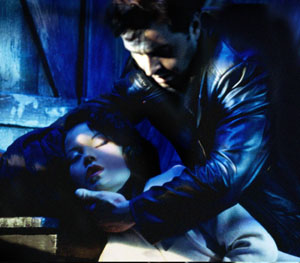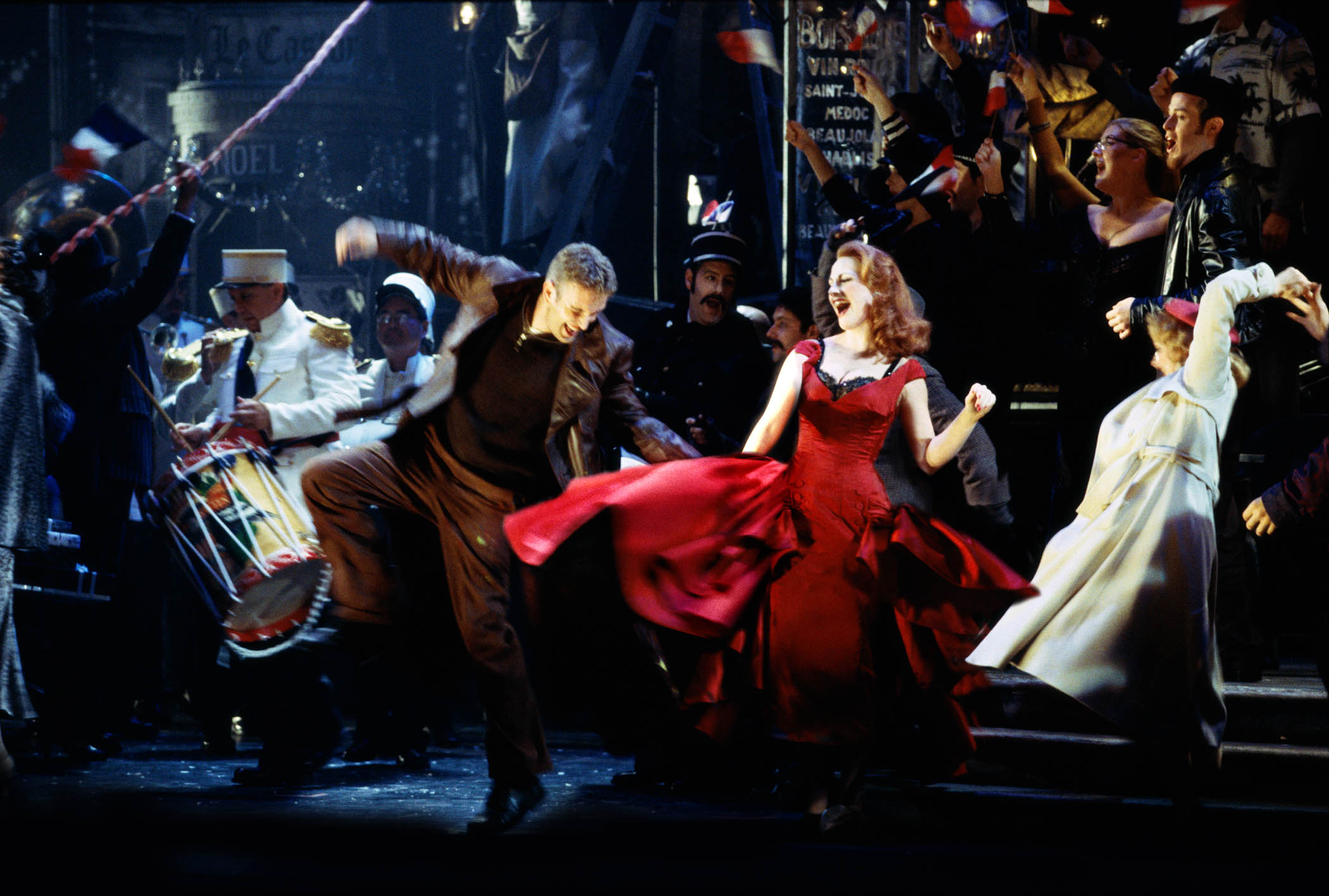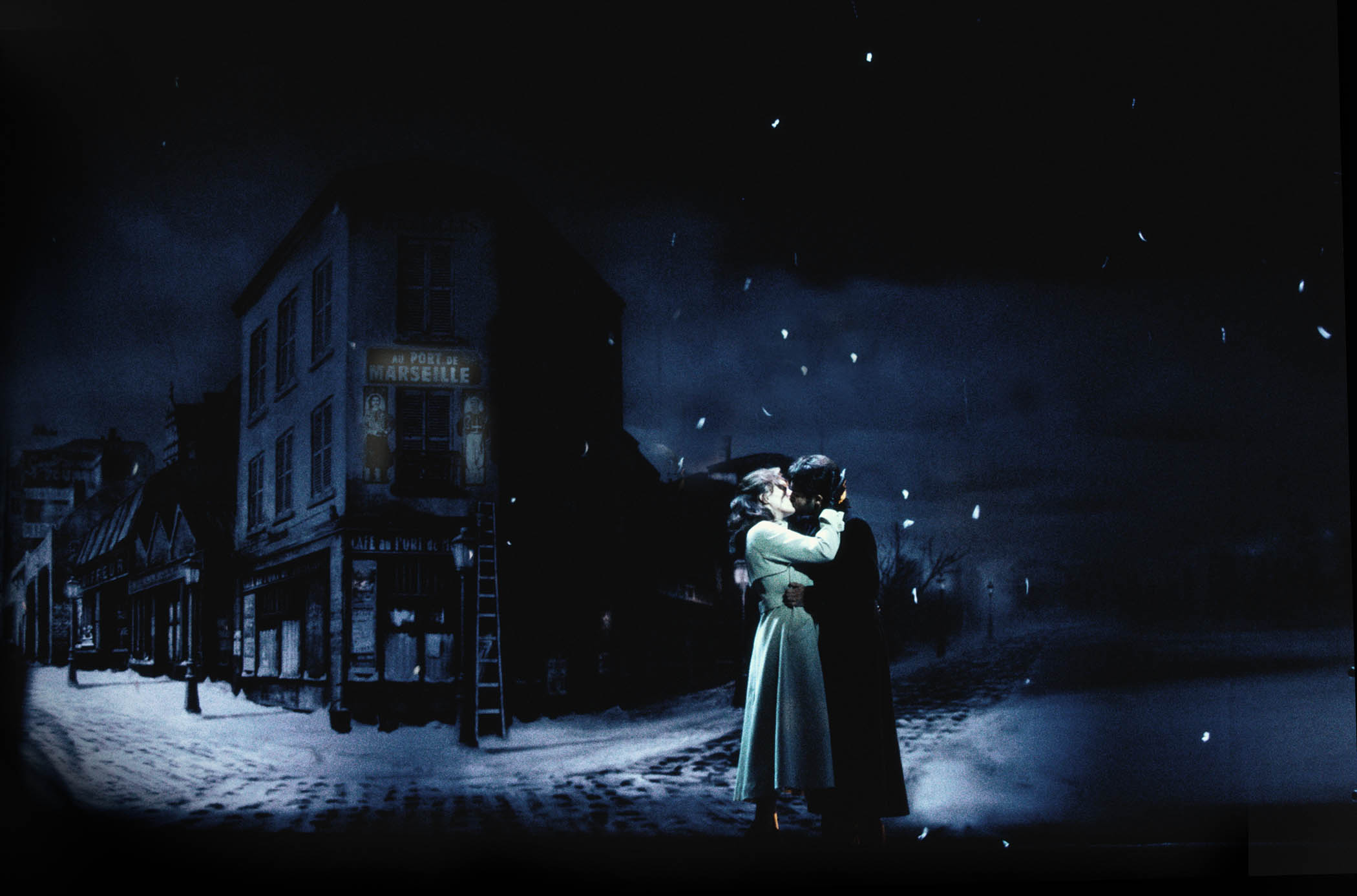Luhrmann Impresses the Bourgeoisie
orLettres de mon Moulin Rouge.
from OperaMusic
The only problem with Baz Luhrman's Puccini's La Bohème on Broadway is that the last two acts are a real down.
Then again, all opera aficionados know that. It only seems to make a difference in this version, when so much of the production is full of life, that it seems a pity that they couldn’t find a miracle cure for Mimì this time around, much akin to the 19th century happy endings for Hamlet.
For all the hype and bother about the production, this strikes one as more authentic than most, because it is full of unabashed artifice, and is played by a young ensemble that took more than 3 rehearsals to get there, and knows they will not be leaving town to sing Rigoletto on Friday night in Fort Worth. The cool precision with which the actors and the choreographed stagehands meld the scenes together and fabricate an almost cinematic version of this time-flogged story is half the fun, and certainly half the action. It’s 1951 or so, on Paris’s left bank, and these are real bohemians who paint on canvas with siphons, eat in the bathtub, and type on an Olivetti. You cannot find a better quartet than these four youngsters crawling over each other to keep warm like puppies, to scrape together a living out in the streets of the Latin Quarter.
I have always found the first act of this opera quite an opera in itself, and don’t know why someone hasn’t put it on a bill with something like Trouble in Tahiti as two one-acters. What’s missing? It’s got action, humor, pathos, drama, love interest, and a happy ending. Who needs more? All right, I’ll keep that in abeyance for now.
 |
|---|
The Mimì in this production is worldly wise. Yes, she is dying and coughing as do all good heroines penned by Luigi Illica. But her entrance and the whole scene leading up to “Che Gelida Manina” take on an entirely new dimension in irony when we see that neither she nor Rodolfo is really looking for this silly key, and the pantomime in the dark is about something else altogether. (If you know that early misprint in the vocal score, Rodolfo really is loking for Mimi's dolcissimo...) On that tender A-flat note that begins Rodolfo’s aria, he is all the way across the room from her, and she, feigning no more pretense about it, extends her arm and he rushes across the stage to hold her hand, thus subverting Signor Illica, and making it more impassioned than Puccini had envisioned. (But you have to know the original scenario to appreciate this re-write).
Benoît is a gem. Who knew he should have looked like Inspector Clouseau all along? There is someething of Peter Sellers and Colonel Klink, too, in his characterization.
Another lesson that all opera companies should take notice of is the brilliant use of titling in this production. There are not one or two spots to seek out the projected English translation, but seemingly dozens of locations. The titles appear on flying panels, doorways, under the proscenium, to right, to left, large, small, helping the audience direct their attention, instead of distracting it. (The translation itself is very funny with its 1950s argot, although not as wildly off the mark as publicity might have you think). And lastly, the use of fonts in the projections is a critical element that no one has used before, to my knowledge. In “O Soave Fanciulla” the font gets loopier and loopier, as though a lunatic had gotten into the foundry, coinciding with Rodolfo’s passion going over the top. Mimì pours cold water on him, not only with her simple “No,” but her font suddenly retreats to Helvetica Medium: a perfect consonance with the mood. Such lines as “Obbedisco, signor!”—‘I obey you, sir,’ which always made me gag anyway, is delivered as a joke, with Mimì rolling her eyes as she says it. Great ideas – most of which couldn’t be done anywhere else, without this setting, without this young cast.
I was disappointed in the last few measures, with both Rodolfo and Mimì vocalizing up to the high C, instead of him accompanying her on the f and e below that. I really truly feel that it is important to the story that he be chivalrous to her at this juncture and take the low-road, not competing with her stratospherics. Because they're both off-stage and both vying for top dog I've always felt you can't adequately hear either of them. But I suppose it’s too personal to me to worry about.
 |
|---|
The real problem comes in Act II, which is so over the top and busy that you need to see this show four times to catch all that’s going on. Franco Zeffirelli be damned: this is a cramped, busy little street with stores, whorehouses (I don’t recall that in the libretto, but Illica would love it) and a charming little kiosk reading "IL CASTOR." Strange thing, this Castor. This is the newspaper—“The Beaver”— for which Rodolfo was writing in Act 1. Even though Luhrmann shows the name on the kiosk in Act II, the pleasant joke in the original about ‘keeping the beaver’s tail from getting long’ went untranslated in the first act, and only old sods like me would catch it. Perhaps it was too confusing to a public who would take it for a more salacious, if not less clear joke about beaver and tail. But it does point up the idea that the more you know about this opera the more you'll see what happend to it.
The act scuttles along, with hookers displaying their wares in their French windows, Schaunard declaring that the ‘D’ is false (on a saxophone!) and the group of bohemians lighting in the Momus Café that opens up on stage like a hibiscus. Musetta arrives like a tornado, and is no longer a flirtatious cocotte, but a downright hellion! What she does to poor Alcindoro is not simply naughty, it’s criminal.
The act concludes with a fabulous scene worthy of Mr. Luhrmann’s best creative vision, complete with tricolor streamers, drapeaux, and a most enthusiastic brass band. And yet, as the cold reality of the intermission descends, the audience has to face the fact in horror—there’s nowhere to go but down. truly, it may not be worth coming back to see the rest.
Seeing that we’ve got so much boisterous creativity on the boil here anyhow, I have a suggestion for Mr. Luhrmann. This whole thing should be done as a flashback. We start out with Act IV, have poor Mimì expire then and there, and have them all sit around and reminisce about when they met her. Boom, we go right into Act I. Happy happy at the end, and then intermission with everyone in a good mood.
 |
|---|
After intermission, we see Act III, all full of drama and tension, when the lovers have a terrible fight, but voilà, we then swoosh the settings right into Act II, where we see they’ve all made up and are spending Christmas together again. The act ends—the opera ends—and the audience is transported on a cloud out of the theater.
I mean, why not?
All right, it would take a couple of re-writes to the lines, but not much. I suppose once I have a taste of what great verismo might look like when you could take such deep artistic license with it, I brake for no one. What could Baz work on next? Think of it! Fanciulla, taking place around an Alaskan Pipeline. Tosca, now set in Iraq, with Cavaradossi clipping mosaic tiles in a mosque. Benvenuto Cellini, with setting at the Metropolitan Museum of Art. Lady Macbeth of the Fifteenth Voting District, starring Hillary Clinton. The mind truly boggles. But by no means should you stay away from Baz Luhrmann's Puccini's Bohème on Broadway because of any reservations about vocal acuity or miking, or diluting the Art. It’s a splendid mixture all the way through, and if you have any affinity for this work, bring it with you and use it to leverage an even better time.